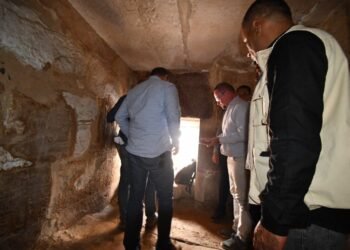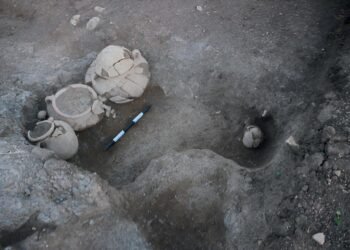Archaeologists from the University of Gothenburg and Kiel University have unearthed a 5,500-year-old stone chamber in the village of Tiarp near Falköping, Sweden.
The findings reveal intriguing details about a dolmen, a prehistoric tomb constructed from large stones, believed to be one of the oldest in Scandinavia.

The dolmen, built around 3500 BCE, stands out as a significant archaeological site, being 200-150 years older than the well-known passage graves in the Falköping region. Karl-Göran Sjögren, an archaeologist from the University of Gothenburg, remarked, “It’s one of the oldest stone burial chambers in Sweden and across the whole of Scandinavia.”
The excavation, conducted in the summer of 2023, uncovered a burial chamber seemingly untouched since the Stone Age. However, the discovery came with a mysterious twist – numerous skulls and large bones, including thigh and arm bones, were notably absent, contrasting with typical megalithic graves where smaller bones from feet and hands are usually missing.

Karl-Göran Sjögren expressed the anomaly, stating, “This differs from what we usually see in megalithic graves. Usually, the bones that are missing are smaller bones from feet and hands.” The missing bones, possibly removed during or shortly after burial, present an enigma that researchers are eager to unravel. Sjögren speculated, “We don’t know whether that has to do with burial rituals, or what’s behind it.”
Torbjörn Ahlström, a Professor of Osteology at Lund University, conducted a detailed study of the skeletal remains, revealing that the bones belonged to at least twelve individuals, spanning from infants to the elderly. Despite the absence of signs of violence on the bones, the cause of their deaths remains unknown. DNA studies are underway to explore possible diseases and establish familial connections among the buried individuals.
“The preliminary DNA results show that the DNA in the bones is well-preserved. This means we will be able to reconstruct the family relationships between the people in the grave, and we are working on that now,” said Sjögren, highlighting the potential for genetic analysis to unveil more about the community and relationships within.
The discovery’s age predates the widespread arrival of agriculture in the area by about 500 years, indicating that the buried individuals were likely early farmers. Chemical analysis of the bones supports this, revealing a diet based on grain cultivation, animal husbandry, and the consumption of dairy products.
Falköping’s cultural heritage is rich with over 250 passage tombs, but the Tiarp dolmen stands out not only for its age but also for its unique construction. Unlike other tombs in the region, it features small niches at each end, adding to its distinctive character.
The findings were published in the Journal of Neolithic Archaeology.






















